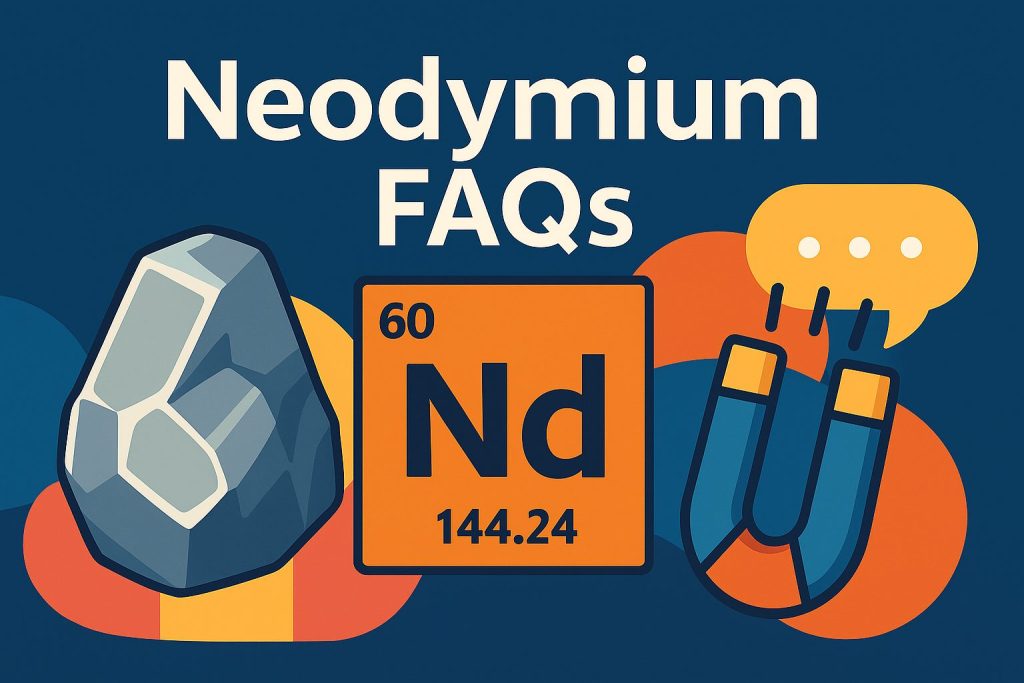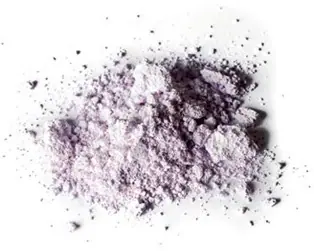The Rare Earth Magnet That Powers Modern Life (and Lifts 1,000x Its Weight)

Neodymium may not be a household name, but it’s inside nearly every household device. From the high-pitched hum of your earbuds to the silent force turning wind turbine blades, this rare earth element is the quiet giant behind modern magnetism.
In this FAQ, we answer the most common (and uncommon) questions about neodymium: what it is, where it’s found, how it’s used, and why it might just be one of the most powerful metals you’ve never heard of.
🔬 Properties & Physical Behavior
Neodymium is a rare earth metal known for its extraordinary magnetic properties. In fact, it’s used to make the strongest permanent magnets on Earth. In its metallic form, it’s silvery with a faint pink hue and forms a purple-blue oxide when exposed to air. It’s relatively soft, but as a magnet, it’s a powerhouse, able to lift over 1,000 times its own weight.
Neodymium is a naturally occurring element (symbol Nd), not a compound. However, neodymium magnets are typically made by combining neodymium with iron and boron (NdFeB), which together form a crystalline structure with incredible magnetic strength.
In its raw metallic form, neodymium is a lustrous silver with a slight reddish tinge. However, it tarnishes quickly, forming a purple-blue oxide layer that flakes off in air. For investment purposes, neodymium is typically sold in its oxide form: a fine, powdery material with a distinct pale violet hue, as shown below. This is the form most commonly stored and traded by industry and private investors alike due to its stability and high purity.
Neodymium is the driving force behind high-performance magnets. It also adds color to glass and ceramics and improves the strength of metal alloys.
Their strength comes from the crystal structure of the NdFeB alloy, which aligns magnetic domains in a very tight, stable formation. This allows them to generate intense magnetic fields with relatively little material.
📖 History & Discovery
Neodymium was discovered in 1885 by Austrian chemist Carl Auer von Welsbach. He isolated it from an earlier-discovered compound called didymium, which turned out to be a mix of neodymium and praseodymium.
Carl Auer von Welsbach gets the credit, although earlier work by Swedish chemists like Carl Mosander and Per Teodor Cleve laid the groundwork.
The first commercial neodymium magnets were developed in the early 1980s by researchers at General Motors and Sumitomo Special Metals. The goal? A cheaper, stronger alternative to expensive samarium-cobalt magnets.
Neodymium sits in the lanthanide series with the atomic number 60. It’s nestled between praseodymium and promethium.
🌍 Origin & Production
Neodymium doesn’t occur in pure form in nature but is extracted from rare earth ores like monazite and bastnäsite. These ores are mined in a handful of countries, with China dominating global production.
Neodymium is extracted as part of complex chemical processes from rare earth mineral concentrates. After mining, the ore goes through separation and refinement, often involving solvent extraction and ion-exchange techniques.
China is the largest producer by far, but other notable sources include Australia (Lynas Corporation) and the United States (MP Materials at Mountain Pass).
Refining companies and magnet manufacturers, mostly in China, Japan, and South Korea, turn the oxide or metal into usable forms like magnets or industrial alloys.
The United States holds significant neodymium resources, primarily at the Mountain Pass mine in California. However, while the U.S. has reserves, it still relies heavily on imports, especially from China, for processing and refined neodymium products. Due to its strategic importance, neodymium is on the U.S. critical minerals list.
⚙️ Uses & Applications
Neodymium’s number one application is magnets. These are used in wind turbines, electric vehicles, and consumer electronics. The rest is used in glass tinting, lasers, and metallurgy.
They’re made from an alloy of neodymium, iron, and boron (NdFeB). These are then sintered or bonded into various shapes and sizes, depending on the application.
You’ll find neodymium magnets in:
– Wind turbine generators
– Electric vehicle motors
– Hard drives and data storage
– Headphones and loudspeakers
– Magnetic resonance imaging (MRI) machines
– Robotics and industrial automation
The atomic structure of NdFeB aligns magnetic domains into a powerful, stable configuration. The result is a compact magnet with a very high magnetic energy product, ideal for space-constrained applications.
A well-made neodymium magnet can retain most of its magnetic strength for over 50 years, assuming it’s not exposed to heat, corrosion, or mechanical damage.
Neodymium’s price reflects a mix of high demand and complex supply chains. It’s essential for manufacturing powerful permanent magnets, which are crucial in electric vehicles, wind turbines, and modern electronics. While this raw material isn’t extremely rare, extracting and refining it is technically challenging and environmentally regulated, especially outside of China. Add rising global demand and geopolitical uncertainty, and you get a price that tends to climb.
🧪 Safety & Handling
In solid form, it’s generally safe. But neodymium dust (from grinding or manufacturing) can be toxic if inhaled and should only be handled in industrial settings with proper ventilation.ed around structural metals.
Absolutely. Their strong magnetic fields can interfere with pacemakers, erase credit cards, or disrupt sensitive electronics. Handle with caution.
Their strength is part of the problem; they can snap together suddenly and cause injuries like pinched skin or broken fingers. Small magnets also pose a swallowing hazard.
Yes, especially in humid environments. That’s why they’re usually coated with nickel, epoxy, or gold to prevent corrosion.
Yes, and in fact, recycling rare earth magnets is becoming increasingly important as demand rises and supply remains concentrated. Specialized processes can extract and reuse neodymium from old devices.
💼 Buying, Investing & Storage
You can find neodymium magnets on countless e-commerce platforms, but if you’re looking for investment-grade neodymium in oxide form, you’ll need to work with a specialist dealer. We offer certified neodymium for private investors, sourced directly from top-tier producers.
Investing in neodymium means physically owning it as a tangible asset. At Strategic Metals Invest, we help you purchase and securely store neodymium in its oxide form, ensuring full documentation and the ability to resell directly into industry.
For investment purposes, storage in a bonded, high-security facility is ideal. Our partner vault in Frankfurt offers tax-free storage with full insurance and professional packaging, making resale fast and straightforward. Home storage isn’t recommended due to humidity and oxidation risks.
Whether you’re a curious mind, a budding technologist, or a future investor, understanding neodymium means understanding the backbone of 21st-century innovation. Its strength lies not just in its magnetic pull but in the way it connects clean energy, data storage, and industrial efficiency. If you’re thinking about the future, neodymium is already part of it. Contact us for more information on how to add neodymium to your investment portfolio.


